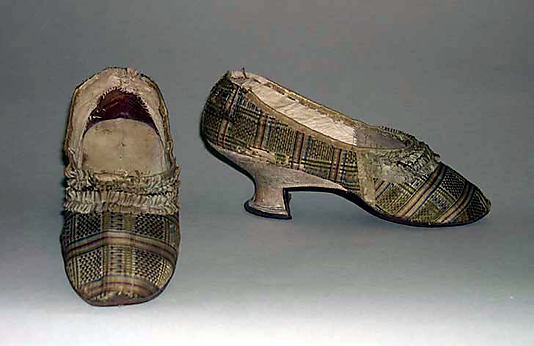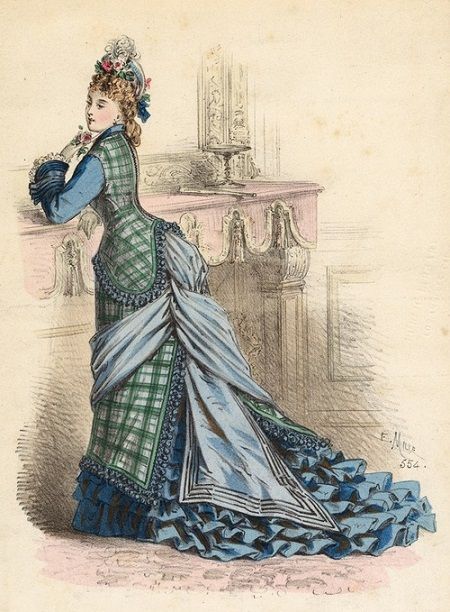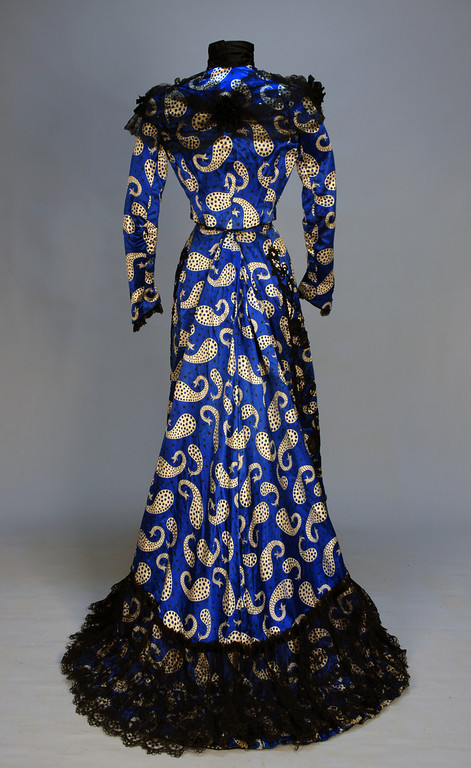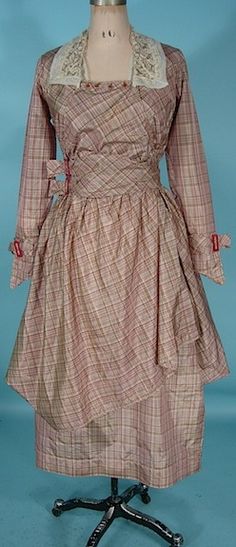The 14th Challenge in the Historical Sew Fortnightly 2014, due Friday the 1st of August is Paisley & Plaid.
This challenge is all about pattern, and all about contrasts and similarities. Paisley and plaid are quite interesting as patterns, because both patterns are instantly recognizable: the only patterns that are more easily named and identified are spots and stripes. Both patterns come in thousands of interpretations and variants. One is quite recent, and the other is a very ancient. Both are strongly associated with specific cultures, though our cultural associations for each pattern are, in many ways entirely inaccurate.
Plaid (or tartan or check, depending on where you are from in the world and how you define it) is one of the most ancient textile patterns. In fact, it is the most ancient known textile pattern. The oldest textile fragments that definitively have a pattern are woven in a checked plaid pattern. When most people hear plaid they think of Scotland, but in fact almost every culture in the world that has woven fabric has used the plaid/check design. There are pre-Columbian plaid fragments from South America, and checked cloth from Bronze age tombs in China. Bog mummies in Northern Europe were interred in plaid garments, and Egyptian tomb walls depict foreigners in boldly plaid tunics. Variations of plaids and checks have been used around the world in every century.
Paisley, on the other hand, is quite a recent pattern, at least in Western design. While swirls are a common motif, the boteh (as the paisley motif is properly known) wasn’t introduced to the West until the 18th century. Paisley is often thought of as an Indian motif (and the name paisley comes from a town in Scotland where what were essentially ‘knock-off’ boteh patterned products were made) but it probably originates in Iran. The motif as we know it today, however, was actually hugely influenced by Western aesthetics and demands for more exotic prints in the 19th century. In order to please Western consumers, it became longer, more twisted and sinuous.
I personally love both paisley and plaid, for their aesthetic, for their interesting histories, and perhaps just a little out of sheer contrariness, because they both have a reputation for being a bit bad taste (there is even a book called ‘Paisley Goes with Nothing’)!
Here are a few of my favourite paisley and plaid inspiration pieces (and there are hundreds more on my Plaid and Paisley pinterest boards!)
Could there possibly be anything better than 18th century plaid shoes?
This particular ensemble didn’t do very well as a ‘Rate the Dress’, but I personally think it is rather fabulous:
And of course, you all know I love Regency kashmiri shawl gowns:
For something lovely and simple, what about this adorable bag (which is actually incredibly elaborate crochet):
I know you’ve seen this before (and I’ve even reproduced it!) but I’m going to include this because I love it SO MUCH and I feel the need to continue showing it for every possible challenge that it would qualify for!
This 1870s plaid gown just makes me swoon with the deliciousness of it. It’s very high on my to-make list!
OK, I’ll confess. I like this one just because it is so hilariously, awesomely bad, and because the paisley motif is so unusual in its execution (and thank goodness for that!)
On a more subtle note, the 1910s aren’t usually an era we associate with paisley, but this evening dress is rather sublime:
I absolutely adore this ‘teens plaid dress. The way the pattern plays with the fabric grainlines is so cunning.
And how chic is this plaid parasol?











I’d have preferred spots and stripes, but that’s me. 🙂
I need to sit down and think about what to do with plaid, and where to get a suitable plaid to do it with.
I’ve despised paisley for pretty close to 20 years, but this challenge has me thinking twice about it. I got a couple of nice paisley prints out of my mum’s stash (specifically with this challenge in mind) that I’ve got some ideas for, so we’ll see how it goes 🙂
I had planned to skip on this channel, not a fan of either paisley or plaid. Then I found that I have a piece of lovely navy/brown plaid quite heavy wool in my stash, a remnant from my first ever serious sewing project. I want to make something vintage that I can wear everyday, but I really have to think about it. It’s not enough for a dress, so a skirt is the obvious option, but maybe I can cram out a jacket from it.
I’ve always loved paisley, but not as an overall print or in a loud Austin Powers version. More as Indian bedspreads and Geeta t-shirts 🙂 And now that I live in Nepal, I’m just astounded by the incredible variety of gorgeous prints that are available everywhere and often feature paisley as part of wonderfully creative designs. But that stuff doesn’t seem to make its way much to the West. I guess there are an increasing number of Indian designers like Tanvi Kedia doing projects for Anthropologie, but generally the West gets maybe 1 percent of the variety we have here in terms of cool prints. Plaids are indigenous here, too; as you’d mentioned, they’re everywhere!
Incidentally, that is such a lovely crinoline era petticoat … I’d like it to be a skirt today! That 1913 cream-colored dress is terrific, too. If this was Rate the Dress (or Rate the Petticoat), they’d get double 10s.
I have a sari I want to turn into a dress inspired by Amelie Auguste (sadly, just inspired, nothing close to that stunning fabric of hers!). It has very, very tiny paisley-ish bits in its border. Would it count? 😛
I love that petticoat and the bright blue one is kind of awesome.
This is so funny. Just after I commented on this, my husband came back from a trip where he had a chance to run into India for a few hours, and he surprised me by bringing back some fabric with paisley! LOL, funny coincidence. He’d never heard the terms “boteh” (or “paisley” for that matter), but says he’s heard the pattern referred to as “shankha” (conch shell). He’s Nepali and also speaks Hindu and Urdu. Tomorrow I’ll be around a lot of Kashmiris, and I am so going to ask them what THEY call it.
Aaaak! Edit: “Hindi,” not Hindu. Ouch.
Most of my paisley fabric is 1970’s vonella, wish it was easier to find nice paisley. Plaid is much easier to find.
I like paisley and plaid – but not together (imagination shuts down in protest).
I’m looking forward to this one. I usually like plaid and I never met a paisley I didn’t like. You know the blue paisley banyan you have on your paisley Pinterest page? I’ve decided I need one of those.
A couple of days early! It’s a bustle pad with little paisleys in the stripe pattern.
http://mala-14.livejournal.com/153498.html
I made checked empire era dress :
http://thehouseofoldfashion.blogspot.com/2014/07/hsf14-empirowa-suknia-kratke-hsf14.html
I made a Vogue paisley 1938 jacket!
http://dollycreates.blogspot.com/2014/07/a-1938-ensemble-in-paisley.html
I would love to be on your list of “Challengers.” Could you add me to that? Thank you so much!!
1880s pleated plaid skirt!
http://thedreadedseamstress.blogspot.com/2014/08/historical-sew-fortnightly-14-paisley.html
Done, I completed a 1903 plaid vest.
http://sewingfromanothertime.wordpress.com
Prentice
A bit late.
The Bobby Soxer Plaid Skirt
https://amodernneedle.wordpress.com/
For my entry I opted to make two different variations on early period hoods – both in the same plaid wool.
http://dawnsdressdiary.wordpress.com/2014/08/01/hoods-two-ways/
Flannel shirt for my son.
http://foggygardens.blogspot.com/2014/09/paisley-and-plaid-historical-challenge.html
http://wandabvictorian.wordpress.com/2014/07/28/hsf-14-challenge-14/
[…] #14: Paisley & Plaid – this is when I first joined the HSF, and I started fairly small with two plaid hoods to meet the challenge requirements. […]
[WORDPRESS HASHCASH] The comment’s server IP (192.0.82.33) doesn’t match the comment’s URL host IP (192.0.78.12) and so is spam.
[…] The Challenge: Pailsey and Plaid […]